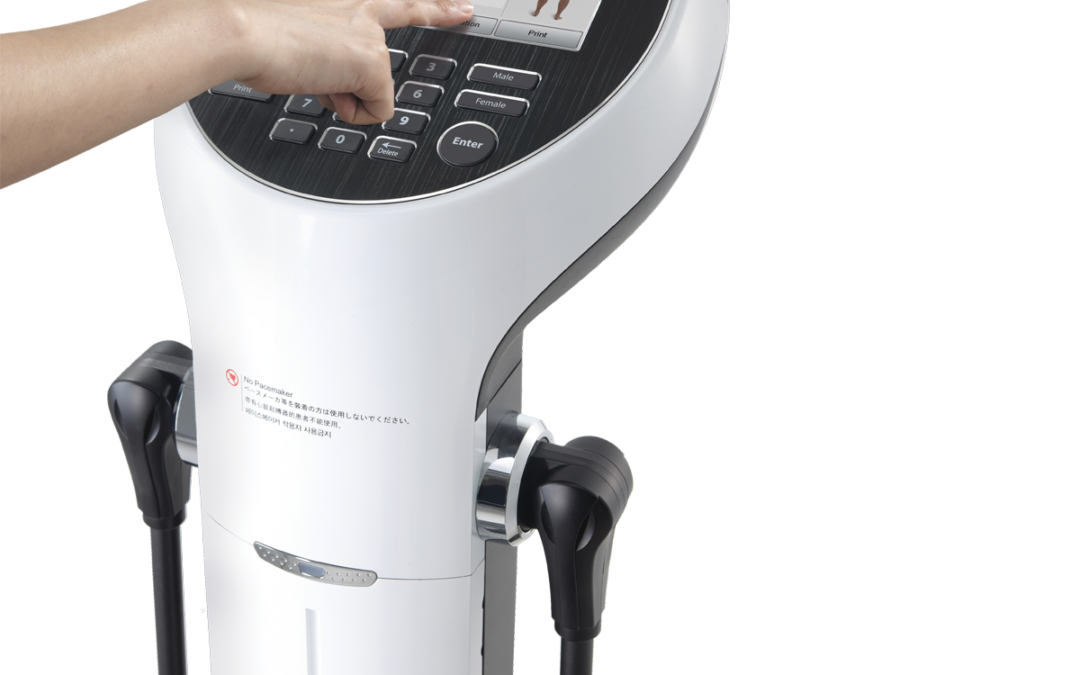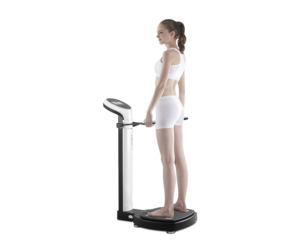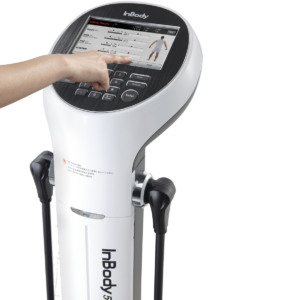InBody 570
Body Composition Analyzer
The InBody 570 goes beyond traditional body composition analysis. It not only analyzes how much fat and muscle you have, but it also measures your Total Body Water and divides it into Intracellular Water and Extracellular Water, values important for understanding a user’s fluid distribution in medical, wellness, or fitness contexts.
Article from InBody Website:
If you’ve ever tried to lose weight before, you may have heard the rule of thumb that a 3,500 calorie deficit results in about one pound of fat loss. In other words, if your daily caloric requirement is 2,500 calories and you spend seven days eating just 2,000 calories, you’re likely to lose around one pound of fat.
But when it comes to muscle, there’s no rule of thumb explaining how to put on (or lose, for that matter) a pound of muscle mass.
Why not?
Because it’s not a simple equation. Unlike losing fat, putting on muscle isn’t as straightforward as causing a calorie surplus. Your body can’t choose to funnel all the extra calories in that ice cream straight to your muscles.
Gaining muscle may seem even more daunting as a female. You don’t want to look bulky and masculine, especially because you need testosterone to build muscle.
Your body is an intricate machine that takes various inputs to produce muscle growth. Especially if you’re wanting to build muscle for some kind of fitness challenge, you’ll need to know how building muscle works so you can set a realistic goal for yourself. This article will lay out the factors that go into gaining muscle and answer the question: “How much muscle can you realistically gain in one month?”
The Three Pillars of Muscle Growth
Understanding the primary factors that drive muscle hypertrophy, or growth is the first step toward answering how much muscle you can build in one month.
The typical gym rat in college might tell you that to build muscle, you just need to “lift big, eat big, bro.” He’s onto something, but you’re likely to benefit from a more scientific approach.
Building muscle comes down to three inputs: nutrition, exercise, and hormones. Let’s take a look at how each of them affects your muscle growth.
1. NUTRITION
The term nutrition is defined as “the process of providing or obtaining the food necessary for health and growth.” At the most fundamental level, muscle growth starts with the nutrients that you put into your body.
People trying to gain muscle generally eat lots of protein. After all, the 20 amino acids that makeup protein are the building blocks of muscle.
Your body can manufacture many of those 20 amino acids, but nine are known as essential amino acids (EAA) because they can’t be made in the body. Instead, you have to consume EAAs from food sources, including meat, beans, nuts, soy foods, and so on. Consuming a diet containing mixed amounts of amino acids can help maximize muscle protein synthesis.
When consumed with a complete protein source containing all 20 amino acids, leucine is responsible for many of the anabolic (muscle-building) processes that follow. This is known as the “leucine trigger concept,” since sufficient quantities of leucine trigger muscle protein synthesis. So it’s pretty apparent that protein is important when it comes to muscle gains.
But a word to the wise about the general recommendation to “eat more protein” – protein alone is not the only macronutrient responsible for muscle growth. In fact, there appears to be a limit to the amount of protein one can consume to maximize muscle gain. Additionally, it takes energy to build muscle, and this means you need a positive caloric balance in order to achieve muscle growth.
If you want to build muscle, increase your dietary protein intake– but don’t exclude your carbs and your fats. Carbs and fats aren’t all bad for you! All three are important for muscle growth, and thus a diet balanced in carbs, protein, and fats is the most effective way to build muscle.
But remember, it’s not just the calories. Physical activity is also key to promoting muscle development.
2. RESISTANCE EXERCISE (STRESS)
Resistance exercise stresses the muscles, and this makes it another of the primary stimuli for building muscle.
Gaining muscle is the result of complex processes inside muscle cells, but the concept can be explained simply:
Your body adapts to resistance exercise by becoming growing or changing to make them more capable of handling it.
The stress of resistance exercise causes muscle injury and breakdown at the cellular level. Then, special muscle cells called satellite cells jump into action to repair, rebuild, and grow the muscle.
Dialing in the right types of exercises can promote increased muscle growth, so be sure to implement a variety of resistance exercise to your training regimen. And remember, a healthy balance between exercise and rest is necessary to support healthy hormone levels and maximize gains.
3. HORMONES
Three primary hormones that stimulate muscle hypertrophy (growth) are insulin-like growth factor 1 (IGF-1), growth hormone (GH), and testosterone.
After weight training, increases in these hormones correspond with muscle protein synthesis, one of the key processes in muscle hypertrophy.
Essentially, these hormones signal to the muscle that it’s time to repair and build up after a session in the gym. GH also happens to be released in the greatest quantities during sleep, so remember that getting a good sleep helps you attain your body composition goals.
When nutrition, exercise, and hormonal effects combine, that’s when the muscle-building magic really happens. Figuring out the right balance for you will be essential for reaching your goals.
How to Manage Your Muscle Gains
Your body’s individual response to the three primary stimuli for muscle growth can vary. Let’s break down several influential factors. They can directly impact how much muscle you expect to gain in a month.
SUPPLEMENTING MUSCLE GROWTH
Muscles need the right fuel to grow. Supplementation is simply an extension of the nutrition pillar. Supplementing with protein has been long known to boost help muscle hypertrophy, and fueling with the EAAs is especially important to provide the nutrients your body can’t synthesize.
After weight training, consuming protein stimulates muscle protein synthesis by supplying providing amino acid building blocks. Traditionally, 20 grams of protein has been considered enough. Researchers recently found that experienced lifters doing whole-body workouts may need about 40 grams instead.
Then again, some people go to the extreme with protein intake, which just isn’t necessary. As noted above, consuming more than approximately 1.6 grams per kg of body weight per day has no additional benefit for building muscle. Excess protein is burned for energy like carbohydrate and fat, excreted in urine, or even stored as fat.
Timing could also be important: research shows intaking protein before bed during a resistance training program is especially helpful for building muscle mass.
Note: While supplements may be beneficial for promoting muscle recovery and growth, they are only effective when combined with a balanced diet and exercise plan. More on supplements and their effects can be found here.
SO WHAT SHOULD YOU EXPECT?
Just like muscle can’t turn into fat, fat can’t turn into muscle.
However, no matter how finely you tune the three stimuli (hormonal, nutrition, resistance exercise), it is unlikely that the body will be able to utilize all of the additional calories for muscle growth. Some of the caloric surplus needed to gain muscle is going to be stored as fat, and that’s OK.
Only the most stringent of diet and exercise protocols has been shown to result in simultaneous muscle gain and fat loss. One of the researchers involved even called the protocol “grueling and unsustainable”, so probably not an ideal strategy when we’re already juggling so many other things in our lives.
The point is this: If you want to gain muscle, you need to accept that you’ll probably have some slight fat mass gain. It’s just being realistic.
WHAT IF YOU’VE HIT A PLATEAU?
Gaining muscle mass is all about forcing the muscle to adapt to novel stress. It’s no surprise, then, that gains come more readily to novices than experienced weightlifters. For novice lifters, the right weight training program should be enough novel stimulus in the gym. Recent research suggests hypertrophy can be measured in as little as one month. On top of that, there seems to be an upper limit to muscle gain. Experienced lifters should be closer to that ceiling than novices, making their incremental gains smaller.
How can the experienced weight lifter overcome this challenge? By introducing different and new nutritional or resistance stimuli.
The principle is simple: change up your routine. Since trained muscles learn to adapt better to consistent training stimuli, adding variation will challenge the muscles in a different way and promote further growth.
The muscles you train also dictate your potential to gain. Your arms have a much lower total potential to gain muscle than your hips and legs. They’re simply smaller muscle groups.
Don’t begin skipping your upper body lifts just yet, though. Research shows that arm muscles may be quicker to hypertrophy than legs. In other words, the ceiling is lower, but the rate of gain relative to what’s already there is quicker.
WHAT IF YOU’RE NOT AS YOUNG AS YOU USED TO BE?
Older adults may have a particularly hard time building muscle. Unfortunately, as you age, your body’s response to weight training is diminished. The muscle building machinery is still there, but it may require more input to achieve desired results.
To overcome this hurdle, use ‘novel stimulus’ thinking from the previous section. Try consuming some extra protein or adding a few new exercises to your routine. The goal is to convince your body to adapt to what you’re throwing at it.
Building muscle may be harder than it was in your youth, but it can still be done.
So what’s a realistic expectation for muscle growth for men vs.women?
It’s time to estimate how much you can reasonably gain in one month. It can be very frustrating seeing a man have an easier time putting on muscle. Due to the differing physiological makeup of men and women, we will discuss hypertrophy for men and women separately.
THE FACTS FOR MEN
Remember that study we referenced earlier? The goal was simple: lose fat while packing on muscle. It worked –participants gained about 1.2 kg (2.6 lbs) of lean body mass and lost fat mass – but it was totally unsustainable. The cornerstone of this program was daily heavy circuit training, HIIT and sprint-interval workouts, and plyometric workouts, all while restricting calorie intake to just 60% of daily requirements and taking in high doses of protein supplements.
A word of caution: don’t try that program at home.
What you can take away is that those men, who had never lifted weights before, gained over 1 kg of lean body mass in just one month.
Another group of researchers decided to try a more sustainable program on a smaller scale, and guess what? The men gained a respectable 4 kg of skeletal muscle in 16 weeks. That means the rate of muscle gain was almost identical to the grueling, unsustainable program – about 1 kg per month.
This program, consisting of just five exercises (squat, knee extension, knee flexion, bench press, and lat pull-down), was certainly more realistic.
Based on the research, it’s reasonable to expect untrained men to be able to gain about 1 kg, or 2.2 lbs, of muscle per month in the beginning of an exercise program.
But what about experienced weightlifters? Because experienced lifters will likely have a slower rate of progression, the amount of gain will be generally lesser and depend on the level of training experience of the individual.
THE FACTS FOR WOMEN
Females tend to be less muscular than men, and most people believe it’s harder to build muscle as a female. This tends to be blamed on a lack of testosterone among females.
It’s true that females struggle to put on as much muscle, in terms of absolute mass, as males. There’s a fairly simple explanation.
Muscle hypertrophies in proportion to the baseline quantity of muscle mass, so women gain less muscle mass than men because their baseline muscle mass tends to be lower.
How much muscle gain is typical for young women? One study says about 0.5 – 0.7 kg in the first month for novice weightlifters. This program involved just two lifts – the squat and the deadlift. You might be left wondering what happens when women undergo a whole-body weightlifting program.
Women’s arms gain muscle at about 3 times the rate as legs (gain of 9.7% in arms vs. 3.3% in legs). But that study says women can expect about 1.5 kg of muscle mass gain in 20 weeks of training, averaging out to 0.3 kg per month.
Since body composition wasn’t measured at any point during the 20 weeks of training, there’s no way of knowing whether the participants gained muscle more quickly in the first month or two and then improvements leveled off. Those numbers would indicate whether a whole-body program is preferable to the simple squat and deadlift program that resulted in more muscle gain.
Nevertheless, on average, you can conclude that women stand to gain about 0.5 kg, or 1.1 lbs, in the first month of their training.
So is that the end of the discussion? Not exactly. Remember, each individual is different and not everyone will be able to sustain a consistent diet and exercise routine to promote muscle development for extended periods of time. This is why research on this topic is more scarce than you might think. Many researchers measure muscle hypertrophy by looking at changes in the circumference around limbs or by imaging cross-sections of the body. This allows them to understand muscle growth in terms of volume changes in different body segments (arms, trunk, legs).
However, newer technology, such as Direct Segmental Multi-frequency Bioelectrical Impedance Analysis (DSM-BIA), provides a quicker, less invasive way of measuring muscle mass in addition to other components of the body.
Conclusions
Altering your body composition is no easy feat. It takes patience, effort, and commitment, but it’s definitely within your reach.
To recap, your body primarily needs three basic stimuli to build muscle: nutrition, resistance exercise, and hormones. You can and should manipulate nutritional and exercise stimuli to keep your body responding.
If your current daily protein intake is 0.8 g / kg of body weight, try bumping that up to 1.5 g / kg if your doctor says it’s okay. If you currently lift twice per week, try gradually increasing to three or four sessions per week. And if you don’t do resistance exercise at all, it’s time to start!
The muscle gains for males and females listed earlier are averages. Some people will gain substantially more, and some will gain less over the course of a month. But in general, the average is about 1 kg for males and 0.5 kg for females.
To have the best chance of building muscle, stick to a training, nutrition, and recovery plan. Make sure you get your body composition measured to set a baseline and track your progress to figure out whether your fitness regimen is working for you. If you don’t meet the average values mentioned above in the first month, use the opportunity to change up your routine.
There’s no secret to building muscle. The key is to get over the hurdle immediately in front of you, whether that’s stepping foot in a gym for the first time or overcoming a plateau you’re stuck in.
Armed with the tips and realistic expectations from this article, you’ll be on your way to a better body composition in no time.




Recent Comments